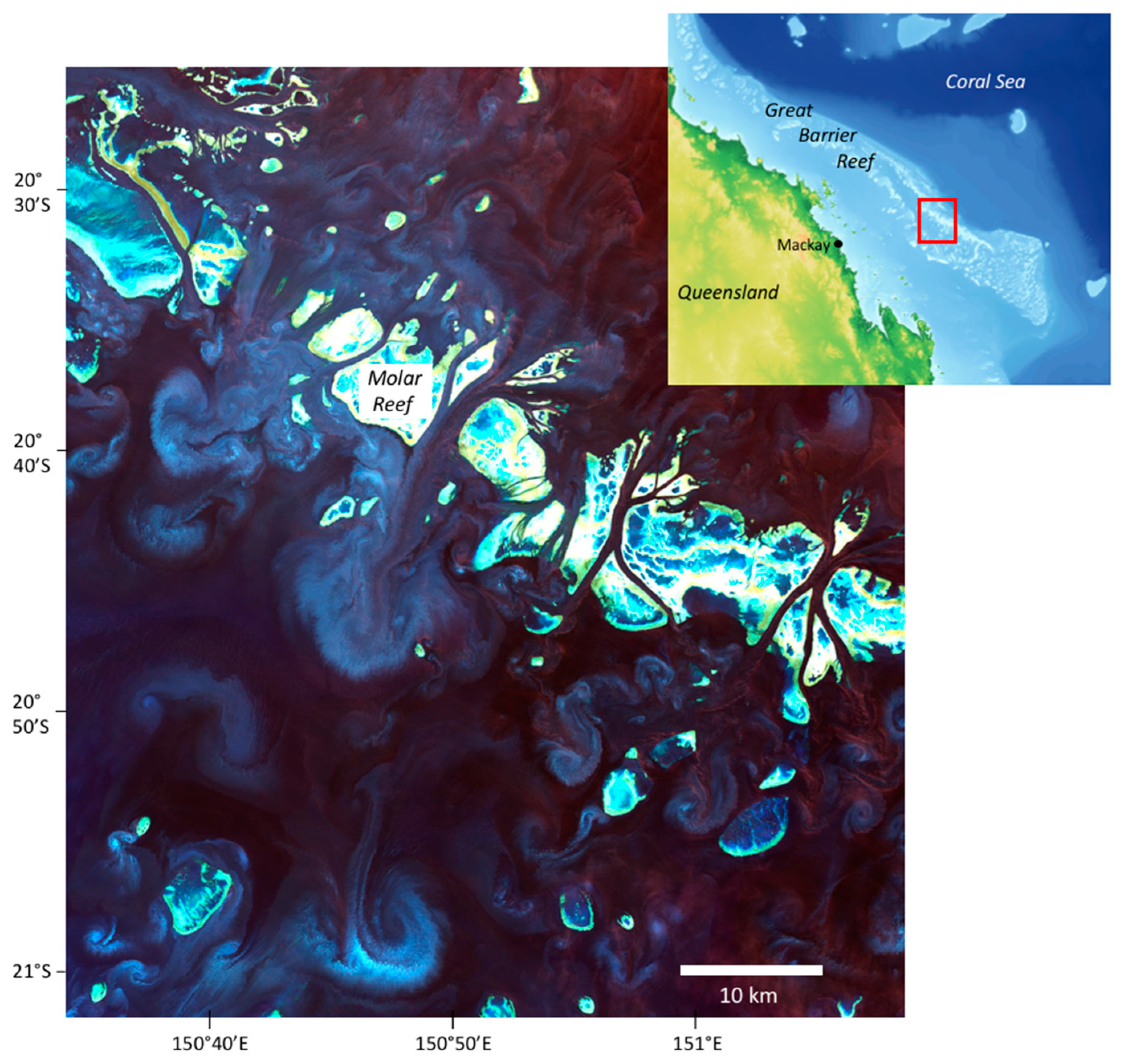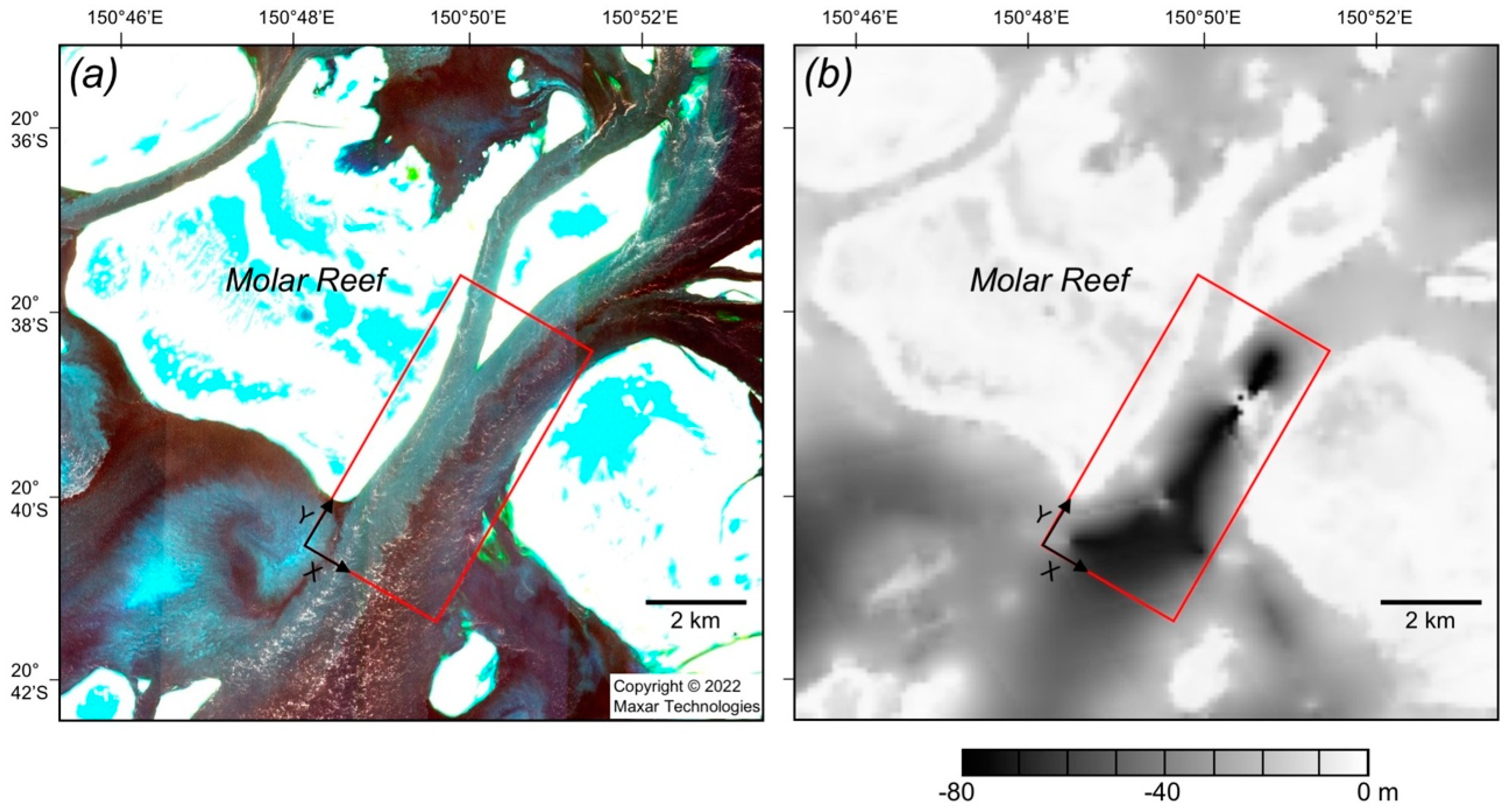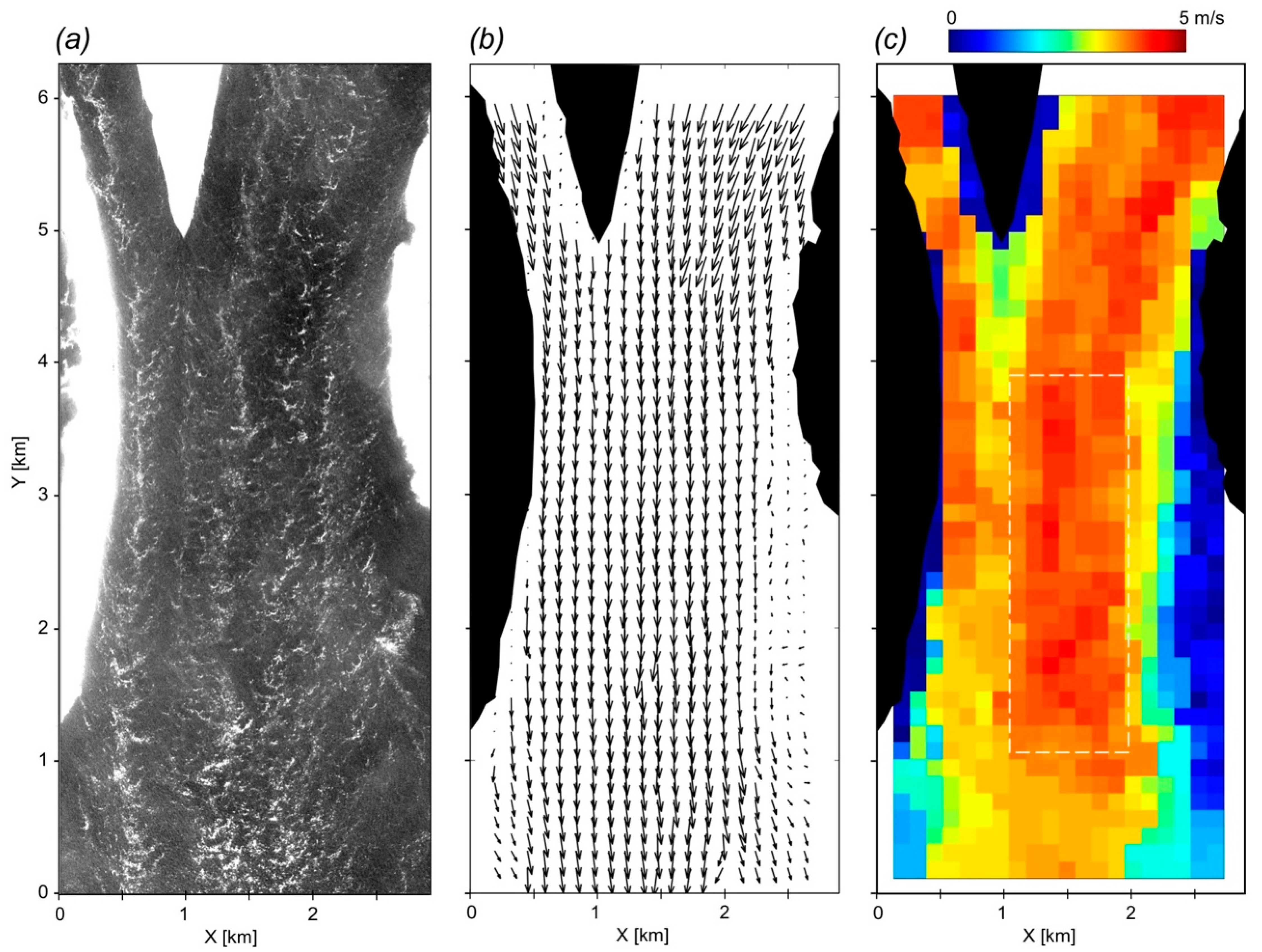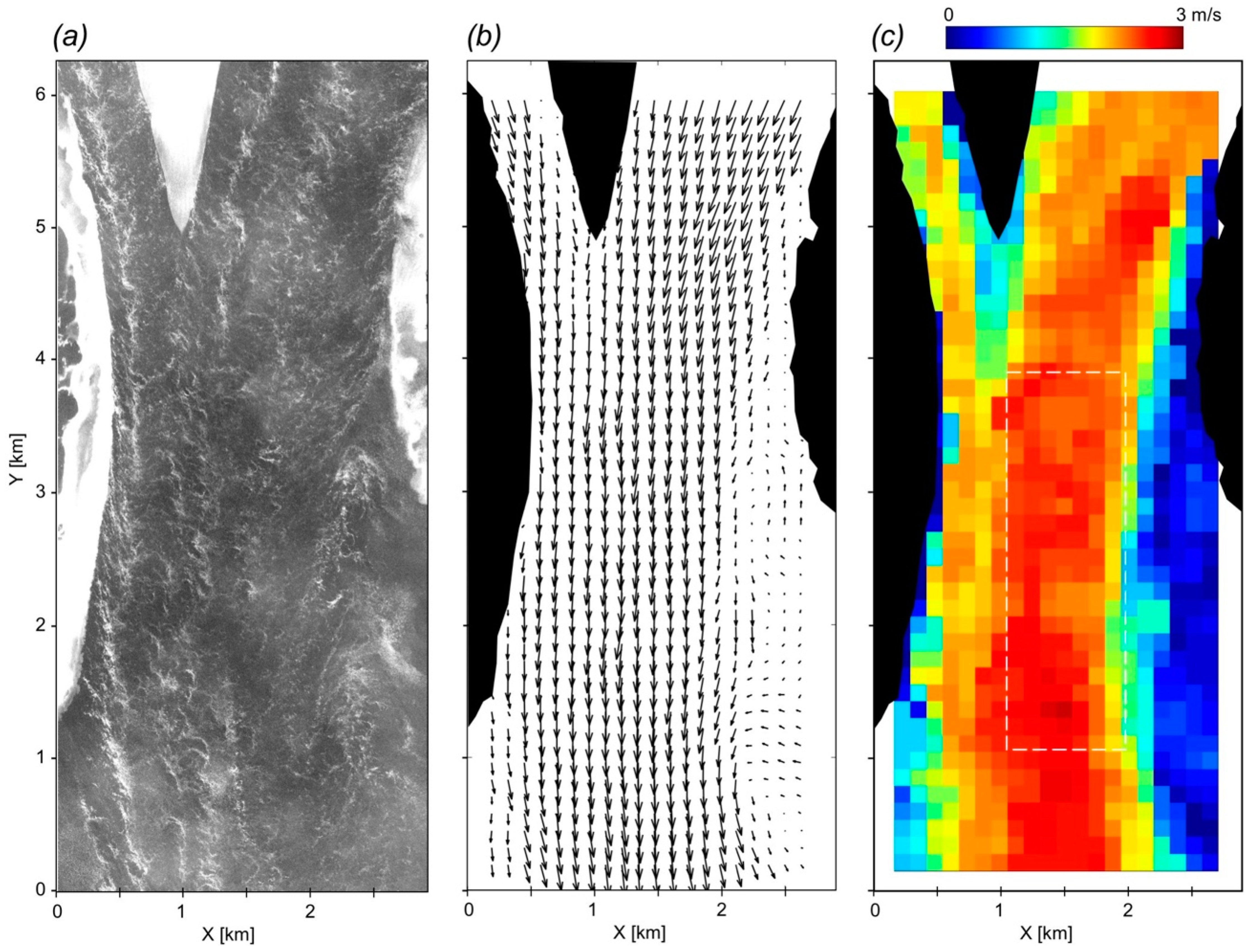Investigation of Turbulent Tidal Flow in a Coral Reef Channel Using Multi-Look WorldView-2 Satellite Imagery
Abstract
:1. Introduction
2. Materials and Methods
2.1. Study Area
2.2. Satellite Data
2.3. Molar Reef Environmental Conditions
2.4. Deriving a Velocity Field from Image Pairs
3. Results
3.1. Nature of the Boil Signatures
3.2. Surface Velocity Fields
4. Discussion
5. Conclusions
Supplementary Materials
Funding
Data Availability Statement
Acknowledgments
Conflicts of Interest
References
- Qazi, W.A.; Emery, W.J.; Fox-Kemper, B. Computing ocean surface currents over the coastal California current system using 30-min-lag sequential SAR images. IEEE Trans. Geosci. Remote Sens. 2014, 52, 7559–7580. [Google Scholar] [CrossRef]
- Delandmeter, P.; Lambrechts, J.; Marmorino, G.O.; Legat, V.; Wolanski, E.; Remacle, J.F.; Chen, W.; Deleersnijder, E. Submesoscale tidal eddies in the wake of coral islands and reefs: Satellite data and numerical modelling. Ocean Dyn. 2017, 67, 897–913. [Google Scholar] [CrossRef]
- Nimmo Smith, W.A.M.; Thorpe, S.A.; Graham, A. Surface effects of bottom-generated turbulence in a shallow tidal sea. Nature 1999, 400, 251–254. [Google Scholar] [CrossRef]
- Thorpe, S.A.; Green, J.A.M.; Simpson, J.H.; Osborn, T.R.; Smith, W.N. Boils and turbulence in a weakly stratified shallow tidal sea. J. Phys. Oceanogr. 2008, 38, 1711–1730. [Google Scholar] [CrossRef]
- Marmorino, G.; Chen, W.; Mied, R.P. Submesoscale Tidal-Inlet Dipoles Resolved Using Stereo WorldView Imagery. IEEE Geosci. Remote Sens. Lett. 2017, 14, 1705–1709. [Google Scholar] [CrossRef]
- Chickadel, C.C.; Horner-Devine, A.R.; Talke, S.A.; Jessup, A.T. Vertical boil propagation from a submerged estuarine sill. Geophys. Res. Lett. 2009, 36, L10601. [Google Scholar] [CrossRef] [Green Version]
- Marmorino, G.O.; Smith, G.B.; Miller, W.D. Surface imprints of water-column turbulence: A case study of tidal flow over an estuarine sill. Remote Sens. 2013, 5, 3239–3258. [Google Scholar] [CrossRef] [Green Version]
- Slingsby, J.; Scott, B.E.; Kregting, L.; McIlvenny, J.; Wilson, J.; Couto, A.; Roos, D.; Yanez, M.; Williamson, B.J. Surface Characterisation of Kolk-Boils within Tidal Stream Environments Using UAV Imagery. J. Mar. Sci. Eng. 2021, 9, 484. [Google Scholar] [CrossRef]
- Lieber, L.; Langrock, R.; Nimmo-Smith, W.A.M. A bird’s-eye view on turbulence: Seabird foraging associations with evolving surface flow features. Proc. R. Soc. B 2021, 288, 20210592. [Google Scholar] [CrossRef]
- Longuet-Higgins, M.S. Surface manifestations of turbulent flow. J. Fluid Mech. 1996, 308, 15–29. [Google Scholar] [CrossRef]
- Fujita, I.; Komura, S. Application of video image analysis for measurements of river-surface flows. Proc. Hydraul. Eng. 1994, 38, 733–738. [Google Scholar] [CrossRef]
- Fujita, I.; Hino, T. Unseeded and seeded PIV measurements of river flows videotaped from a helicopter. J. Vis. 2003, 6, 245–252. [Google Scholar] [CrossRef]
- Legleiter, C.J.; Kinzel, P.J. Inferring Surface Flow Velocities in Sediment-Laden Alaskan Rivers from Optical Image Sequences Acquired from a Helicopter. Remote Sens. 2020, 12, 1282. [Google Scholar] [CrossRef] [Green Version]
- Legleiter, C.J.; Kinzel, P.J. Surface flow velocities from space: Particle image velocimetry of satellite video of a large, sediment-laden river. Front. Water 2021, 3, 53. [Google Scholar] [CrossRef]
- Marmorino, G.O.; Smith, G.B.; Miller, W.D. Turbulence characteristics inferred from time-lagged satellite imagery of surface algae in a shallow tidal sea. Cont. Shelf Res. 2017, 148, 178–184. [Google Scholar] [CrossRef]
- Marmorino, G.; Chen, W. Use of WorldView-2 along-track stereo imagery to probe a Baltic Sea algal spiral. Remote Sens. 2019, 11, 865. [Google Scholar] [CrossRef] [Green Version]
- Beaman, R.J. Project 3DGBR: A High-Resolution Depth Model for the Great Barrier Reef and Coral Sea. Marine and Tropical Sciences Research Facility (MTSRF) Project 2.5i.1a Final Report; MTSRF: Cairns, Australia, 2010; pp. 1–13. [Google Scholar]
- Tseng, Q.; Duchemin-Pelletier, E.; Deshiere, A.; Balland, M.; Guillou, H.; Filhol, O.; Théry, M. Spatial organization of the extracellular matrix regulates cell–cell junction positioning. Proc. Nat. Acad. Sci. USA 2012, 109, 1506–1511. [Google Scholar] [CrossRef] [Green Version]
- Schneider, C.A.; Rasband, W.S.; Eliceiri, K.W. NIH Image to ImageJ: 25 years of image analysis. Nat. Methods 2012, 9, 671–675. [Google Scholar] [CrossRef]
- Wolanski, E.; Spagnol, S. Sticky waters in the Great Barrier Reef. Estuar. Coast. Shelf Sci. 2000, 50, 27–32. [Google Scholar] [CrossRef] [Green Version]
- Andutta, F.P.; Kingsford, M.J.; Wolanski, E. ‘Sticky water’ enables the retention of larvae in a reef mosaic. Estuar. Coast. Shelf Sci. 2012, 101, 54–63. [Google Scholar] [CrossRef] [Green Version]
- Wolanski, E.; Drew, E.; Abel, K.M.; O’Brien, J. Tidal jets, nutrient upwelling and their influence on the productivity of the alga Halimeda in the Ribbon Reefs, Great Barrier Reef. Estuar. Coast. Shelf Sci. 1988, 26, 169–201. [Google Scholar] [CrossRef]
- Young, I.R.; Black, K.P.; Heron, M.L. Circulation in the ribbon reef region of the Great Barrier Reef. Cont. Shelf Res. 1994, 14, 117–142. [Google Scholar] [CrossRef]
- Wolanski, E.; Pickard, G.L. Physical Oceanographic Processes of the Great Barrier Reef; CRC Press: Boca Raton, FL, USA, 2018. [Google Scholar]







| Day [2020] | Look | Image Identification | Time [UTC] | Δt [s] | GSD [m] | θnadir [°] | ϕtarget [°] | ϕSun [°] |
|---|---|---|---|---|---|---|---|---|
| 22 August | 1 | 10300100ABD88300 | 23:36:33.4 | 1.31 | 51.8 | 237.6 | 50.9 | |
| 22 August | 2 | 10300100AC13F000 | 23:36:48.3 | 14.9 | 1.20 | 50.3 | 241.5 | 50.9 |
| 22 August | 3 | 10300100AC305700 | 23:37:03.3 | 15.0 | 1.10 | 48.7 | 246.0 | 50.8 |
| 22 August | 4 | 10300100ABBA8D00 | 23:37:16.7 | 13.4 | 1.03 | 47.3 | 250.5 | 50.8 |
| 22 August | 5 | 10300100ACAA6D00 | 23:37:29.6 | 12.9 | 0.97 | 46.1 | 255.3 | 50.7 |
| 22 August | 6 | 10300100AC18CF00 | 23:37:41.5 | 11.9 | 0.93 | 45.1 | 260.2 | 50.7 |
| 22 August | 7 | 10300100AB2A2100 | 23:37:53.1 | 11.6 | 0.90 | 44.3 | 265.3 | 50.6 |
| 22 August | 8 | 10300100ABB64A00 | 23:38:04.9 | 11.8 | 0.87 | 43.6 | 270.9 | 50.6 |
| 22 August | 9 | 10300100AA923200 | 23:38:16.6 | 11.7 | 0.86 | 43.2 | 276.7 | 50.5 |
| 4 September | 1 | 10300100AD454900 | 23:57:58.8 | 0.72 | 37.1 | 215.3 | 49.6 | |
| 4 September | 2 | 10300100AC053700 | 23:58:11.3 | 12.5 | 0.66 | 33.6 | 219.0 | 49.6 |
| 4 September | 3 | 10300100ACB3D200 | 23:58:49.4 | 38.1 | 0.54 | 22.2 | 240.0 | 49.5 |
| 4 September | 4 | 10300100AC2A0500 | 23:59:01.1 | 11.7 | 0.51 | 19.3 | 253.0 | 49.4 |
| 4 September | 5 | 10300100AC9F1000 | 23:59:13.8 | 12.7 | 0.50 | 17.3 | 271.1 | 49.3 |
| 4 September | 6 | 10300100ACBAA000 | 23:59:26.4 | 12.6 | 0.50 | 17.1 | 291.3 | 49.2 |
| 4 September | 7 | 10300100A9504100 | 23:59:39.0 | 12.6 | 0.51 | 18.8 | 309.8 | 49.2 |
Publisher’s Note: MDPI stays neutral with regard to jurisdictional claims in published maps and institutional affiliations. |
© 2022 by the author. Licensee MDPI, Basel, Switzerland. This article is an open access article distributed under the terms and conditions of the Creative Commons Attribution (CC BY) license (https://creativecommons.org/licenses/by/4.0/).
Share and Cite
Marmorino, G. Investigation of Turbulent Tidal Flow in a Coral Reef Channel Using Multi-Look WorldView-2 Satellite Imagery. Remote Sens. 2022, 14, 783. https://doi.org/10.3390/rs14030783
Marmorino G. Investigation of Turbulent Tidal Flow in a Coral Reef Channel Using Multi-Look WorldView-2 Satellite Imagery. Remote Sensing. 2022; 14(3):783. https://doi.org/10.3390/rs14030783
Chicago/Turabian StyleMarmorino, George. 2022. "Investigation of Turbulent Tidal Flow in a Coral Reef Channel Using Multi-Look WorldView-2 Satellite Imagery" Remote Sensing 14, no. 3: 783. https://doi.org/10.3390/rs14030783
APA StyleMarmorino, G. (2022). Investigation of Turbulent Tidal Flow in a Coral Reef Channel Using Multi-Look WorldView-2 Satellite Imagery. Remote Sensing, 14(3), 783. https://doi.org/10.3390/rs14030783





